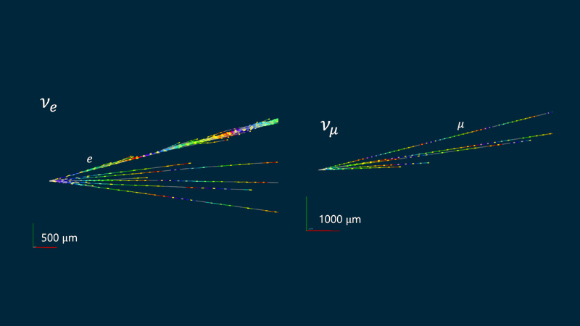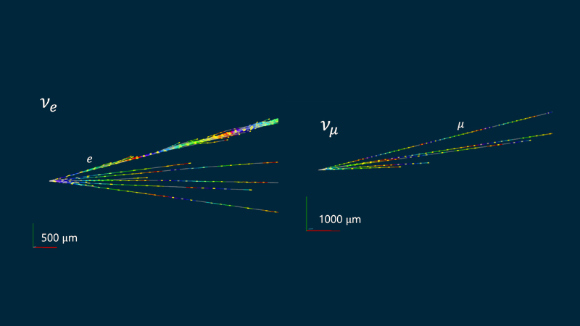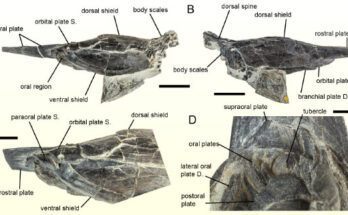The Ahead Search Experiment (FASER) at CERN’s Giant Hadron Collider (LHC) is designed to seek for extraordinarily weakly interacting particles. Such particles are predicted by many theories past the Customary Mannequin which are making an attempt to resolve excellent issues in physics resembling the character of darkish matter and the matter-antimatter imbalance within the Universe. One other objective of the experiment is to review interactions of high-energy neutrinos produced within the LHC collisions, particles which are practically inconceivable to detect within the 4 massive LHC experiments. Physicists from the FASER Collaboration have now introduced a measurement of the interplay power, or cross part, of electron neutrinos (νe) and muon neutrinos (νμ). That is the primary time such a measurement has been made at a particle collider. Measurements of this type can present essential insights throughout totally different facets of physics, from understanding the manufacturing of ahead particles within the LHC collisions and bettering our understanding of the construction of the proton to decoding measurements of high-energy neutrinos from astrophysical sources carried out by neutrino-telescope experiments.

Occasion shows recognized by the FASER Collaboration as candidates for an νe (left) and a νμ (proper) interacting within the detector; invisible right here, the neutrinos arrive from the left after which work together to create a number of tracks spraying out to the fitting (coloured strains), one in all which is recognized as a charged lepton. Picture credit score: FASER Collaboration.
FASER is positioned in a facet tunnel of the LHC accelerator, 480 m away from the ATLAS detector collision level.
At that location, the LHC beam is already practically 10 m away, bending away on its round 27-km path.
This can be a distinctive location for finding out weakly interacting particles produced within the LHC collisions. Charged particles produced within the collisions are deflected by the LHC magnets.
Most impartial particles are stopped by the tons of of meters of rock between FASER and ATLAS.
Solely very weakly interacting impartial particles like neutrinos are anticipated to proceed straight on and attain the situation the place the detector is put in.
The chance of a neutrino interacting with matter could be very small, however not zero. The kind of interplay that FASER is delicate to is the place a neutrino interacts with a proton or a neutron contained in the detector.
On this interplay, the neutrino transforms right into a charged lepton of the identical household — an electron within the case of an νe, and a muon within the case of a νμ — which is seen within the detector.
If the vitality of the neutrino is excessive, a number of different particles are additionally produced within the collision.
The detector used to carry out the measurement consists of 730 interleaved tungsten plates and photographic emulsion plates.
The emulsion was uncovered from July to September 2022 after which chemically developed and analyzed in the hunt for charged particle tracks.
Candidates for neutrino interactions had been recognized by searching for clusters of tracks that might be traced again to a single vertex. Certainly one of these tracks then needed to be recognized as a high-energy electron or muon.
In whole, 4 candidates for an νe interplay and eight candidates for a νμ interplay have been discovered.
The 4 νe candidates characterize the primary direct statement of electron neutrinos produced at a collider.
The observations will be interpreted as measurements of neutrino interplay cross sections, yielding (1.2+0.9−0.8)*10−38 cm2 GeV−1 within the case of the νe and (0.5 ± 0.2)*10−38 cm2 GeV−1 within the case of the νμ.
The energies of the neutrinos had been discovered to be in a spread between 500 and 1,700 GeV.
No measurement of the neutrino interplay cross part had beforehand been made at energies above 300 GeV within the case of the νe and between 400 GeV and 6 TeV within the case of the νμ.
“Our outcomes are in step with expectations and reveal the power of FASER to make neutrino cross-section measurements on the LHC,” the physicists stated.
“With the complete LHC Run 3 knowledge, 200 occasions extra neutrino occasions can be detected, permitting rather more exact measurements.”
The group’s paper was revealed on-line on the arXiv.org preprint server.
_____
FASER Collaboration. 2024. First Measurement of the νe and νμ Interplay Cross Sections on the LHC with FASER’s Emulsion Detector. arXiv: 2403.12520



